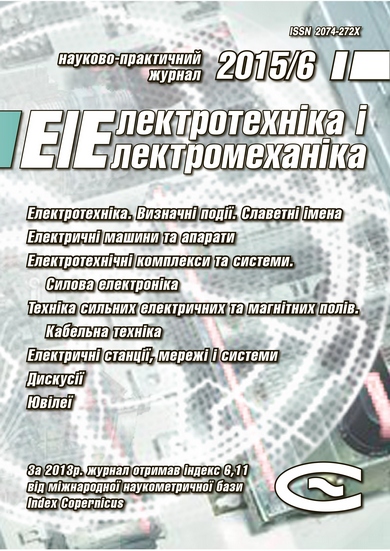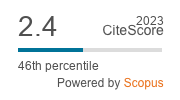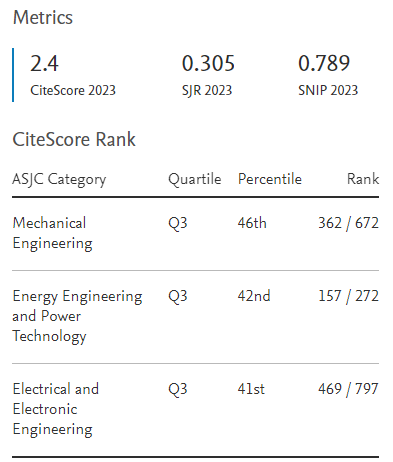DEVELOPMENT OF NEW CHARTS OF CAPACITANCE-RESISTANCE DEFENSE OF HIGH-VOLTAGE CAPACITORS OF POWERFUL CAPACITY STORES OF ENERGY FROM EMERGENCY CURRENTS
DOI:
https://doi.org/10.20998/2074-272X.2015.6.08Keywords:
powerful capacity store of energy, emergency current, capacitance-resistance chart of defense of high-voltage capacitors, high-voltage permanent graphite-ceramic resistorsAbstract
Purpose. Development of new charts of capacitance-resistance defense of high-voltage capacitors of powerful capacity stores of energy (CSE) from emergency large impulsive currents (LIC) at the electric hasp of one of condensers of such CSE on the stage of their charge or discharge. Methodology. Electrophysics bases of the technique of high-voltage and large pulsed currents, and also scientific and technical bases of planning of devices of high-voltage impulse technique. Results. Two new charts of capacitance-resistance defense of high-voltage impulsive capacitors are offered for powerful CSE of one- and multimodule execution from emergency LIC, being based on the use of high-voltage permanent graphite-ceramic resistors of type of TVO-60 a face value from 24 to 100 Ohm, set on the high-voltage conclusions of all of condensers of CSE. One of the developed capacitance-resistance charts of defense of condensers for powerful one-module CSE passed practical approbation. Originality. It is shown that application of the developed charts of capacitance-resistance defense of high-voltage condensers of powerful CSE is provided by frequent limitation of amplitude of emergency LIC, flowing through broken through an electric discharge condenser of CSE on the stage of his charge or discharge. Such limitation emergency LIC is prevented by explosion destruction of the damaged condenser of high-voltage CSE. Practical value. The use of the developed charts of capacitance-resistance defense of high-voltage capacitors from emergency LIC allows substantially to promote functional safety of powerful CSE of one- and multi-module execution and provide the safe terms of labour for a scientific and technical personnel, attendant similar CSE.References
Komel'kov V.S. Tehnika bol'shih impul'snyh tokov i magnitnyh polej. [Technique large pulsed currents and magnetic fields]. Moscow, Atomizdat Publ., 1970. 472 p. (Rus).
Berzan V.P., Gelikman B.Yu., Guraevsky M.N., Ermuratsky V.V., Kuchinsky G.S., Mezenin O.L., Nazarov N.I., Peregudova E.N., Rud' V.I., Sadovnikov A.I., Smirnov B.K., Stepina K.I. Elektricheskie kondensatory i kondensatornye ustanovki. Spravochnik [The electrical capacitors and condenser options. Directory]. Moscow, Energoatomizdat Publ., 1987, 656 p. (Rus).
Gulyi G.A. Nauchnye osnovy razriadno-impul'snykh tekhnologii [Scientific basis of the discharge-pulse technology]. Kiev, Naukova Dumka Publ., 1990. 208 p. (Rus).
Mesiats G.A. Impul'snaja energetika i elektronika [Pulsed power and electronics]. Moscow, Nauka Publ., 2004. 704 p. (Rus).
Koliushko G.M. Issledovanie i razrabotka sistem zashchity dlia emkostnykh nakopitelei energii. Diss. cand. techn. nauk [Research and development of security systems for capacitive energy storage. Cand. tech. sci. diss.]. Kharkov, 1981. 218 p. (Rus).
Baranov M.I. Selection and installation of high-voltage ceramic protective resistors in the charge-discharge circuit powerful capacitive energy storage. Visnyk NTU «KhPІ» – Bulletin of NTU «KhPІ», 2014, no.50(1092), pp.13-20. (Rus).
Baranov M.I. Key indicators thermo protection in high-voltage capacitors charge-discharge circuit powerful capacitive energy storage of emergency overcurrent. Visnyk NTU «KhPІ» – Bulletin of NTU «KhPІ», 2014, no.50(1092), pp.20-27. (Rus).
GOST 11324-76. Rezistory postoiannye ob"emnye tipa TVO [State Standard 11324-76. Resistors constant volume type TVO]. Moscow, USSR State Standard Publ., 1976. 20 p. (Rus).
Baranov M.I., Bocharov V.A., Nosenko M.A. Limit characteristics of the scattered pulse power and high-power ceramic resistors bulk type TVO-60. Visnyk NTU «KhPІ» – Bulletin of NTU «KhPІ», 2007, no.20, pp. 45-56. (Rus).
Baranov M.I., Koliushko G.M., Kravchenko V.I., Nedzelskyi O.S., Dnyschenko V.N. A current generator of the artificial lightning for full-scale tests of technical objects. Pribory i tekhnika eksperimenta – Instruments and experimental techniques, 2008, no.3, pp. 81-85. (Rus).
Neyman L.R., Demirchyan K.S. Teoreticheskie osnovy elektrotekhniki. V 2-kh t. T. 1 [Theoretical bases of electrical engineering. In 2 vols. Vol. 1]. Leningrad, Energoizdat Publ., 1981, p. 536. (Rus).
Baranov M.I. Izbrannye voprosy elektrofiziki. Tom 2, Kn. 2: Teoriia elektrofizicheskikh effektov i zadach [Selected topics of Electrophysics. Vol.2, Book 2. A theory of electrophysical effects and tasks]. Kharkiv, NTU «KhPІ» Publ., 2010. 407 p. (Rus).
Baranov M.I. New resistive circuit protection in high-voltage capacitors charge-discharge circuit powerful capacitive energy storage. Visnyk NTU «KhPІ» – Bulletin of NTU «KhPІ», 2015, no.20(1129), pp. 3-10. (Rus).
Baranov M.I., Koliushko G.M., Kravchenko V.I., Rudakov S.V. A powerful high-voltage generator of aperiodic impulses of current of artificial lightning with the peak-temporal parameters rated on an International Standard IEC 62305-1-2010. Elektrotekhnіka і elektromekhanіka – Electrical engineering & electromechanics, 2015, no.1, pp. 51-56. (Rus).
Downloads
Published
How to Cite
Issue
Section
License
Copyright (c) 2015 M. I. Baranov, S. V. Rudakov

This work is licensed under a Creative Commons Attribution-NonCommercial 4.0 International License.
Authors who publish with this journal agree to the following terms:
1. Authors retain copyright and grant the journal right of first publication with the work simultaneously licensed under a Creative Commons Attribution License that allows others to share the work with an acknowledgement of the work's authorship and initial publication in this journal.
2. Authors are able to enter into separate, additional contractual arrangements for the non-exclusive distribution of the journal's published version of the work (e.g., post it to an institutional repository or publish it in a book), with an acknowledgement of its initial publication in this journal.
3. Authors are permitted and encouraged to post their work online (e.g., in institutional repositories or on their website) prior to and during the submission process, as it can lead to productive exchanges, as well as earlier and greater citation of published work.





